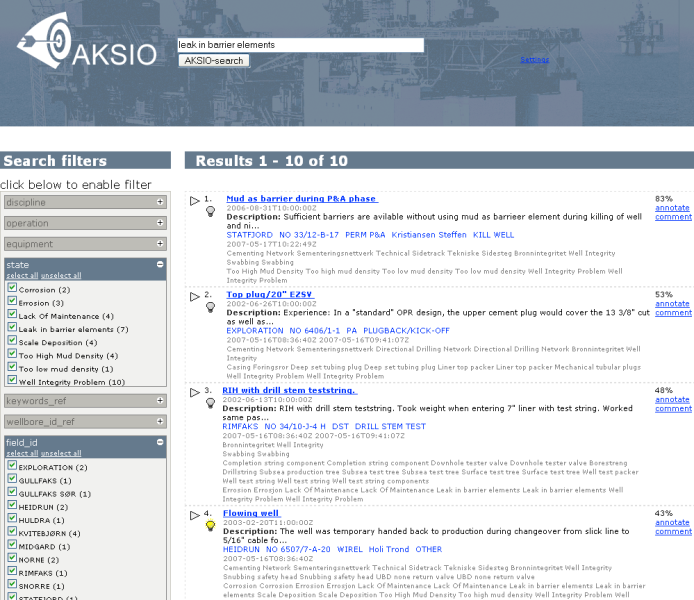September 2007

Integrated Operations are implemented when offshore oil platforms are connected by high-speed data links to on-shore control centers, and multidisciplinary teams collaborate to optimize operations and rapidly solve any problems.
Deep-sea drilling projects are technically sophisticated and highly complex, and require expert knowledge. Even with the extensive use of information technology for monitoring, analyzing and making decisions about projects, knowledge transfer sometimes fails and results in expensive down-time.
The importance of effective Knowledge Management (KM) has for a long time been recognized by the international oil and gas industry. Still, KM challenges have not been solved in a generally satisfactory manner. Shortcomings include unsystematic registration and qualification of knowledge, lack of common terminology, insufficient tools for search, and inadequate management of and linking to tacit knowledge. The Active Knowledge Management for Integrated Operations (AKSIO) aims to better connect knowledge processes to existing core work processes.
The goal of AKSIO is to provide decision makers in drilling processes with the best available knowledge in a task-relevant, timely, and contextual manner. A further goal is to provide feedback loops that capture new knowledge and delete obsolete knowledge.
The AKSIO system focuses on the transfer of inter-project experience both in the planning and operation of the drilling process. The system has been developed and tested for Statoil, which is the largest oil company on the Norwegian Continental Shelf, and covers experiences with over 2,500 drilling operations since the early 90s. A wide range of data is collected including that relating to Health Safety and the Environment.
Drilling operations involve processes for knowledge creation and knowledge reuse (see Figure 1).

Figure 1: KM processes in drilling operations
The individual drilling projects are responsible for recording positive and negative experiences during drilling operations in a module in the reporting system called Daily Drilling Report (abbreviated to DBR in Norwegian). AKSIO adds some crucial missing pieces in quality assurance and annotation, and also links to relevant documents and people. This process is run by the discipline advisors, whose responsibility is to maintain best practices in their respective areas.
The objective of the reuse improvements is to discover relevant experiences that could affect current or planned drilling operations. The improvements in reuse hinge around a search engine that uses an ontology that is embedded in existing work processes (see Figure 2).

Figure 1: Searching for experiences. (A larger screen dump image is also available.)
The shared domain ontology is used for semantic annotation, and for retrieval of information. It is developed collaboratively by the discipline advisors, and covers operations, equipment, events and failure states in drilling operations. It also includes relations between these concepts, for example, to indicate that a particular event may result in a failure state.
AKSIO is built on Semantic Web standards. Experiences are represented in Resource Description Format (RDF), and discipline advisors add comments, semantic annotations, and links to people as RDF descriptions. Concepts from the drilling domain are modeled in Web Ontology Language (OWL), which serves as a backbone on which experiences can be organized and described. It also serves as the backbone for search, ranking and navigation.
AKSIO shows how Semantic Web technology can be used for knowledge management in the oil and gas domain. The system has been tested over a three month period with discipline advisors and one drilling project at Statoil. Computas will continue to pursue this technology approach in this industry and in other domains.
© Copyright 2007, Statoil and Computas AS